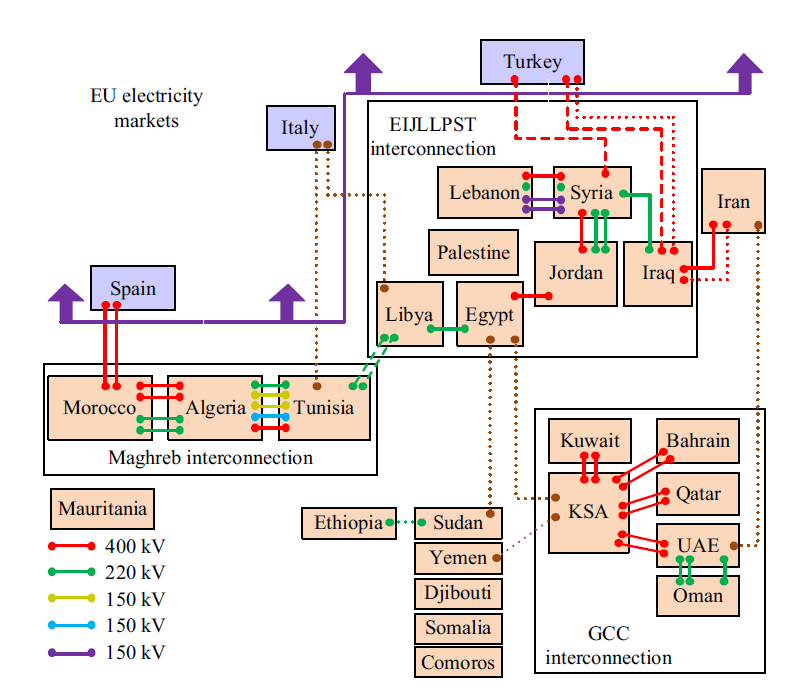This article explores the option for a future completely interconnected power grid in the Middle East and possibly connected to a Europe or worldwide grid. Why do we actually need an integrated grid? What is already been done? And what are the challenges which still need to be overcome to have an interconnected power grid?
Why electricity grid interconnection?
- An integrated energy grid promotes economical efficiency by allowing imports/ exports. Differences in marginal costs of energy production and seasonal demand differences for electricity between countries gives an economic incentive to exchange energy between countries.
- Reserve margins may be reduced. For maintaining grid reliability, a reserve margin is kept. Reserve margin is the maximum power generating capacity minus the expected peak demand. Because grid interconnection increases the maximum power generating capacity whenever required (energy can be imported) the reserve margin which needs to be kept might be reduced (eia.gov link). Furthermore the reserve margin might be shared or pooled between different countries operating on the interconnected grid.
- It acts as fail save. In case there is a problem with the electricity power generation in a country it can import energy from another or vice versa.
- The energy supply mix will be improved. An interconnected grid will have less dependency specific kinds of energy supply as there might a larger variety of generating facilities be connected to the grid (fossil, nuclear, sun, wind, thermal, hydro etc.).
- The load factor (the ratio of average to peak power demand)) might be improved when energy is exchanged between interconnected systems with daily or seasonal variations in load. Systems operate most economically with high load factors. (Energypedia article Technical Aspects of Grid interconnection)
- There are also some cost & reliability benefits related for interconnected systems due to economies of scale for new generation capacity and maintenance. An interconnected grid facilitates the planning of outages of generating and transmission facilities for maintenance reasons.
How does the interconnected grid in the Middle East look like now?
At the moment an effort is placed to interconnect the Electricity grids in the MENA region closer together as well as to the European grid. This has already been (partially) done as we see in the schematic picture below:

Figure 1: Schematic Electricity grid (Zhang et al., 2017, Review of Middle East energy interconnection development). The solid lines are existing connection, the dashed lines are not yet operational and the dotted lines are under consideration for construction.
Roughly speaking there are 3 different interconnected regions in the Middle East which are increasingly getting interconnected. There is the Maghreb interconnection involving Morocco, Algeria & Tunisia, the EIJLLPTST interconnection involving Lebanon, Syria, Palestine, Jordan, Iraq, Libya and Egypt and the GCC interconnection involving UAE, Saudi Arabia, Oman, Qatar, Kuwait and Bahrain. The Maghreb interconnection is connected by Morocco to Spain (Europe) and there are further plans under way to connect the EIJLLPST network to Italy by Tunisia and Libya. Interconnecting to Europe is also advocated by Desertec to integrate the Middle East and European energy markets further to benefit from the potential of renewables in desert areas.
The GCC power grid is interconnected by an HVDC (High Voltage Direct Current) system connecting the 50 Hz systems of UAE, Oman, Kuwait and Bahrain to the 60 Hz Saudi Arabian system (Hassan & Ebrahim GCC Power Grid: Benefits and Beyond). HVDC enables power transmission over vast distances with low electrical losses. Also new HVDC interconnections are under way for example between Saudi Arabia and Egypt (Construction week online article) and Tunisia and Italy (KHL article).
What are the challenges to overcome to obtain a truly interconnected grid?
Technically HDVC systems are recommended to connect the grids between the different countries. AS the examples above illustrate already in current plans and contract awarded it is noticeable that this is the preferred method chosen to interconnect.
Once the grid is interconnected the economic and technical gains ultimately obtained are linked closely together with how optimal the system is operating, e.g. how effectively energy is optimally distributed along the system.
What would help with an optimal system efficiency is a transparent pricing scheme and/or market between the different energy trading parties operating in the interconnected grid. This can be bilaterally determined contracts or it can be determined in a market setting, say Party Ap in Country A needs 2 GW extra power and Part Bp from country B can pitch in as well as Party Cp from country C for the 2GW delivery. This can even be determined in a blockchain setting where the import/export transactions between the different parties are determined and recorded efficiently and independently. As such blockchain can add to further grid interconnection optimization.
What might further impede trade on interconnected grids is the different electricity tariffs between industry & residential consumers in the different countries. The average of residential tariffs is in the Middle East ca. 30 % of EU average tariffs (Zhang et al., 2017, Review of Middle East energy interconnection development) . One of the reasons is that in the Middle East in many countries the electricity tariffs for residential use are kept by means of subsidies below the economic cost of supply.
The different electricity tariffs combined with different degrees of subsidies add complexity and make the interconnected energy trade market less transparent. To promote an efficient energy trading economy, it would be beneficial to align energy tariff and pricing schemes between the different countries and parties part of the interconnected grid.
Furthermore it should be noted that part of the of the Middle East Interconnected Grid areas are located in areas of political and socio-economical unrest. Especially for the countries in the EIJLLPTST interconnection this imposes challenges for effective cross-country power trading.
